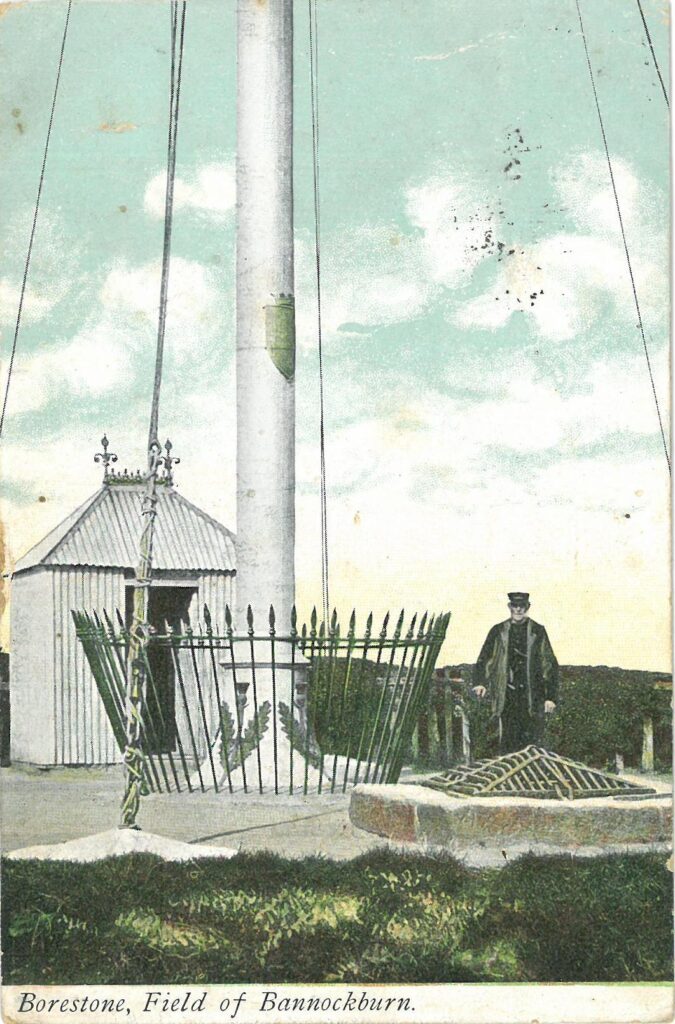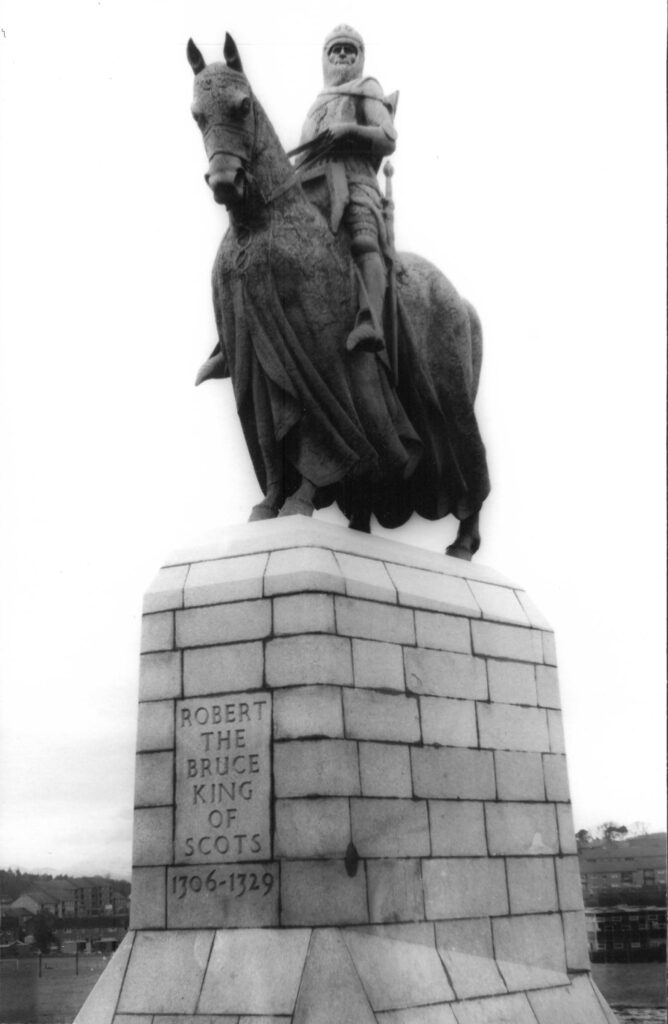So, you must have been to the National Trust Bannockburn Centre? To have joined the thousands to pay homage to our greatest battle, where Scotland’s freedom was secured? But have you ever noticed the famous monument called the Borestone and wondered what it was, exactly?
The Borestone was originally located on Brock’s Brae which is now called Monument Hill. It consisted of a large flat round stone with a hole drilled through the centre of it. The legend concerning it states that it is the stone that Robert the Bruce used to place the pole that carried his standard or flag with the royal insignia on the first day of the Battle of Bannockburn, the bottom of the flagstaff resting in the central hole. The name Bore Stone was given to it simply because the stone was bored through for this specific purpose. Unfortunately, despite being protected by a metal grille, over the years the stone has been progressively chipped away by souvenir hunters, leaving only remnant fragments in the centre of what was supposed to have been a protective cage.
In reality, it is very unlikely that Robert the Bruce would have taken the time and trouble to have someone in his retinue drill a hole in a large stone order to plant his standard. The project would have been time consuming and pointless, when it would have been possible just to stick the pennant into the soft earth of the battlefield. In actuality the stone is likely originally to have been a mill stone quarried on the Abbey Craig and then dropped whilst being transported to a mill, possibly at Chartershall.
Too large to be shifted easily, the stone must have lain there for years while people got used to travelling around it. By the time of the mid seventeen hundreds its true origins had been lost to the mists of time, and a legend had grown up around its presence in that location of the stone having been the spot where Bruce planted his standard, a suitably romantic notion that doubtless appealed greatly to people in the area who were proud of the association with the great fourteenth century triumph for the nation. So famous did the stone become, that people went out of their way to come and look at it, and over time, it became something of a local attraction. Whilst on a tour of Scotland, in 1793, the poet Robert Burns, whilst walking around the supposed site of the famous battle, came to see the Borestone. Burns was so moved by his experiences in Bannockburn that he eventually composed Scots Wha Hae, one of the most famous Scottish poems ever written, which purports to be Bruce’s speech on the first day of the battle to rouse his men before the fighting began.
Scots, wha hae wi’ Wallace bled,
Scots, wham Bruce has aften led;
Welcome to your gory bed – ,
Or to victorie!
The fame that this poem acquired along with the burgeoning interest in Scotland as a destination for holiday trips encouraged more and more people to come and visit the site. In the early years of the following century, Sir Walter Scott wrote another blockbuster poem, The Lord of The Isles, which was published in 1815. It too commemorated the Battle of Bannockburn, and interest generated by its popularity encouraged further tourism to the area. In response to this, a flagpole was erected at the Borestone, and postcards were produced depicting the site, which were sold at a shop nearby and at other local landmarks.
When the fields surrounding the stone were threatened by development, the Bannockburn Preservation Committee under the chairmanship of Edward Bruce, 10th Earl of Elgin and Kincardine, made a gift of land in the area to the National Trust for Scotland. Further land was purchased by the Trust in 1960 and 1965 to allow for the creation of a proper visitors’ centre (with an even bigger shop) and monument complex.
The Bannockburn Centre with its Rotunda and statue of Bruce is a beautiful addition to our local landmarks but it still leaves us with the question: did Bruce really plant his standard here? Given the true nature of the stone, it seems very unlikely. Although the King was in the area at the time of the battle, it isn’t possible to know exactly where this momentous action took place. In a way, it hardly matters, the Rotunda and its surrounding monuments are a war memorial, a place of reflection and commemoration, so therefore it is fitting that the site is memorialised in this way, and that the old legends persist about it.
To finish with another poet. Robert Baston was brought to Scotland in 1314 by the English King Edward to document his ‘victory’. Poor old Robert was captured by the Scots and wrote these lines instead.
Why do I delight in such detail? Why do I sing of massacre? …I lack the skill to name the fallen, nor count their numbers, not how they fell, and not how much death they inflicted. Many fell, many were pierced with arrows, many sunk down into the mud and many were captured alive and bound to be ransomed.

